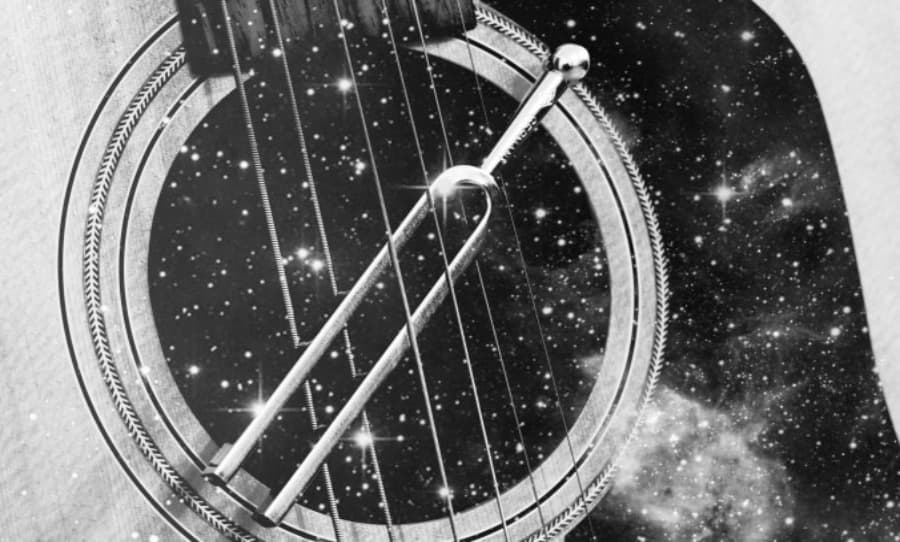A=432Hz, you might have heard of it before. Probably one of those times you stayed up watching YouTube videos until 4 am. Supporters believe that 432Hz should be the tuning for middle A or A4, rather than the current standard 440Hz. They claim 432Hz is the natural tuning of the universe, a cosmic number related to sacred geometry that has relaxation benefits, amongst other things. Some even go as far as to say that 440Hz can incite fear and/or anger, and was a ploy devised by the Nazis in the Second World War.
But how much of this is true? Was the Fleetwood Mac album you just listened to a form of Nazi mind control? I mean it didn’t sound like it… Well, before you read too much into Stevie Nick’s lyrics, let’s take a bit of a dive into the conspiracy to see what holds up and if there are any grounds to this peculiar New Age theory.
A=432Hz. Does it really open your chakras and your third eye? Does listening to 440Hz make you depressed and anxious? Let’s delve into some hard maths and history to figure this one out.
Everybody Hz
For starters, let’s get a bit of a definition down. A little reference before we get too cosmic. So what are Hz? A Hz or Hertz is a standard measurement for frequency, that is defined as one cycle per second. Sound travels as a longitudinal oscillating wave and the human ear detects these as pitch.
Each musical note corresponds to a particular frequency, the higher the pitch the shorter the length of the wave or wavelength. On a side note, all musical notes are related to each other as a fraction or interval, however, the Hz has no relation to this interval as it is a human construct. The importance of this will become apparent later on.
A=432Hz refers to middle A or A4, with a wavelength that measures 79.86cm. In the same tuning, the low C or C3 equals 128Hz, measuring 268.62cm. In the modern standard, A4 equals 440Hz with a wavelength of 78.41cm and low C equals 130.81 which measures 263.74cm. So it’s a small adjustment for a lot of claims.
Alright, now that some of the theory is out of the way let’s take a look back in time to see how the world decided on the modern standard that may have doomed us all. Maybe things are easier without A=432Hz?
A=440, the History of the Modern Standard
When you look back at standard tunings used over time, the picture seems a little less black and white. A=440Hz and A=432 weren’t the only tunings ever used. It wasn’t like one took over and suppressed the other as conspiracists sometimes like to make out. In fact, just a few hundred years ago there were many tunings used and standards often varied from country to country.
In Western traditions, ‘A’ was originally tuned simply to the lowest note monks could sing in their Gregorian chants, not a particularly precise measurement, but I guess it was something. Tuning varied from choir to choir, church to church, town to town, country to country. It wasn’t really something people kept track of a whole lot, more of a matter of “Giveth us an ‘A’ broth’r Edmund.”
After the Renaissance, music started to become a little more complex, and people did start to take more notice of their tuning. It also became a lot easier to keep track of pitch after the invention of the tuning fork in 1711 by John Shore. Some of the earliest surviving forks represented A between 400Hz and 420Hz.
In the years following, however, musicians started to experiment with different tunings, often finding that higher tunings sounded more exciting. This led to a period of ‘pitch inflation’ where musicians, performers and instrument manufacturers tried to outdo each other with the most bright or brilliant sound. A kind of arms race of tuning if you like.
Pitch inflation became particularly prominent with the rise of orchestras. A tuning fork from Dresden Opera House dated to 1815 placed A at 423.2Hz, while another fork from the same place from 1826 has A at 435Hz. Tuning forks rose even higher, with some from around this time pushing as high as 451Hz, such as an example found at La Scala in Milan.
As exciting as higher tunings may have sounded, there were a few problems with all this pitch pushing. For one, it made it difficult for orchestras to play in different countries with different standards, but perhaps the biggest opponents of pitch inflation were singers, who complained that higher pitches strained their vocal cords.

In 1859, the first standard was set by the French government to 435Hz, after widespread protest for a lower standard pitch. Predictably, the British weren’t quite happy with the French’s standards and wanted a higher measure of 439Hz to account for their colder temperatures. This was then bumped up to 440Hz after it was found that 439 would prove difficult to measure and manufacture due to the fact that it was a prime number.
Meanwhile, an Italian composer named Guisseppe Verdi preferred to tune to 432Hz, simply because it was easier for singers and orchestras. Perhaps arguably more practical grounds than aligning one’s chakras.
Regardless, the real standardisation took place in 1926, when American instrument manufacturers chose 440Hz as a standard and began selling them to Europeans. In 1955 the International Organisation for Standardisation rested upon a 44oHz as an international standard, where it has remained ever since (except for a few New Age YouTube channels).
A=432hz, the Case to Tune Down
A quick google search of ‘the benefits of A=432Hz’ will bring up an endless stack of material. It’s a bit dizzying really. Some common claims are that 432Hz brings relaxation by opening your chakras and your third eye. Or that 432Hz is the natural tuning of the universe and it was the preferred tuning of the ancients and relates to sacred geometry. Go a bit deeper and you might get the whole Nazi story. Let’s try flesh some of these out a bit… starting with the Nazi story.
A common basis to some of these claims is the belief that 440Hz can cause adverse effects, however, some say it causes people to become unsettled, hyperactive and ecstatic, while others say it causes lethargy, fear and compliance. In the latter camp are those who believe that 440Hz was adopted by Joseph Goebbels, who served as the Prime Minister of propaganda for the German Third Reich. Apparently, he found the tuning much more suited to spreading the Nazi message than 432Hz.
Well, there isn’t really any evidence for or against this claim, so I’ll let you decide on that one. Let’s take a look at a few of the more tangible theories.

Schumann Resonance and A=432Hz
In 1952, the German Physicist Winfried Otto Schumann discovered electromagnetic resonances between the Earth’s surface and Ionosphere after being struck by lightning. He measured these extremely low frequencies as having a fundamental of 7.86Hz.
Proponents of A=432Hz like to round this number up to 8Hz and claim that this is the ‘heartbeat’ of the Earth and proof of a natural tuning. Taking 8Hz as a starting point and working up five octaves you reach 256Hz. In this scale, A has a frequency of 432Hz, but of course, using the actual integer of 7.86Hz doesn’t give you such nice round numbers.
The Schiller Institute is a big proponent of Schumann Resonance and a certain version of ‘Scientific Pitch’, an alternative mode of tuning where middle C is set to 256Hz so that all octaves of C are round numbers in Hz. However, middle A in this system is 430.54Hz, close I guess. Here’s where it gets strange, the Schiller Institute uses Pythagorean Tuning instead of the standard to reach that magic number, what does that mean exactly?
Let’s Talk Pythagoras
Pythagoras was famous for his maths and there’s no doubt that his work with intervals was incredibly influential and is still relevant today. Pythagoras also devised one of the first standardised means of tuning, which is aptly named Pythagorean Tuning. This system was used for a time in the ancient and medieval world, however, it had its drawbacks and was largely dropped in favour of ‘Equal Temperament’ since the 1700s.
Equal temperament is a system in which the frequency interval between pairs of adjacent notes has the same ratio so that each step is perceived equally. Pythagorean tuning, on the other hand, is based upon ratios from an arbitrary reference pitch, using prime numbers two and three and their powers. The system produces a ‘spiral of fifths’, and consequently a string rather ugly dissonant intervals, namely the ‘wolf fifth’. If you haven’t heard it, give it a listen, it hardly sounds like it’s going to open your third eye.
In his tuning system, 432 arises, as it is a multiplication of the ratio between C and A, C being 1 and A being 27/16, which equals 432/256. But these are just ratios, not Hz and can apply to any base frequency.

While We’re On the Ancients
So while we’re on the topic, let’s address the claim that the ancients were more in perceptive to the sounds of the cosmos, and tuned their instruments accordingly. Conspiracists argue that Tibetan bowls, ancient flutes and Pythagoras’ own monochord were all tuned with 432Hz as their base pitch. Some stretch it as far as Ancient Egyptian instruments and as wide as Amazonian Shamanic chants.
The fact is, ancient instruments have been found with many varied tunings, often between 460Hz and 400Hz or lower. It’s likely that tuning was simply what sounded good at the time, or what worked with other instruments or singers, just like the Gregorian monks.
None of these cultures had any means of calculating cycles per second, let alone Hz… and seeing as the concept of Hertz was only calculated in 1930, how would the ancients, including Pythagoras, have even known to factor in 432Hz into their tunings?
Right Where it Hz
The fact of the matter is that Hz as a measure of cycles per second is a human construct. Before becoming a standard in 1930, they were referred to as ‘Cycles Per Second’. They were only detected for the first time in the 180os by Félix Savart with his ‘Savart Wheel’ and by Johann Scheibler with his ‘Tonometer’. For that matter, seconds didn’t even exist until the late 1500s and in themselves have pretty dodgy maths.
A second is a 60th of a minute, which is a 60th of an hour, which is a 24th of the time it takes to rotate around the Earth. This definition is so shaky and with so many variables, that in fact, the official definition of a second has come to be defined by caesium clocks rather than 1/86,400 of the mean solar day.
In 1967 the 13th General Conference on Weights and Measures stated:
“the second is the duration of 9 192 631 770 periods of the radiation corresponding to the transition between two hyperfine levels of the groundstate of the caesium 133 atom”
So basically the most accurate way of calculating pitch would be in measurements of caesium radiation. Not really as sexy or mystical as sacred vibrational geometry, but that’s just what it is.
So really, A=432Hz is equivalent to 9 192 631 770 divided by 432 = 21279240.20833333333 periods of radiation. On the other hand, A=440Hz is equivalent to 9 192 631 770 divided by 440 = 20892344.93181818181.
Hardly defined maths…
When you boil it down the point is, the universe didn’t decide where 0Hz started, we did.
Final Tune-Up
On one of your YouTube tirades, you may have come across examples of people claiming that they can hear the difference when a song is tuned down to A=432Hz, so how could this be? Is it the cosmos speaking to them? No, it’s actually probably just something called the ‘Levitin Effect’, which basically states that because most people are constantly exposed to standard tuning, any variations sound unique and novel. For this reason, some artists have experimented with different base tunings for their effects.
So what can we take away from all of this? For one, experiment with different tunings, you might find something you like, or you might not. Secondly, when it comes to scales it’s not really the Hz that matters, rather the relationship between intervals that determines the scale, as Hz can be set anywhere and after all, we made them up.
Individuals have different preferences and different frequencies and scales resonate with people differently. Finally, don’t take everything you hear on YouTube at face value, log off it’s time for bed.



